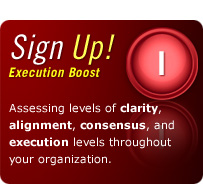Execution Enhancement: Can the EBSS Truly Help?
by John Spence
July 16th, 2006
Below is a chart that explains some of the major concerns that have been expressed over the years in relation to exection enhancement and the solutions EU’s Execution Boost Support System (EBSS) provides. At any time you may click here to return to the Execution Crisis article.
| Execution Enhancement Concern | EBSS Solution |
| Execution enhancement? That takes too much time – with all my employees and responsibilities, I’m already overwhelmed! | To account for the time problem, we have made the EBSS into segments of 15-30 minutes. Sessions will rarely if ever take anyone longer than your average coffee break. Also, the time you save enhancing purposeful doing typically more than makes up for the time spent on the system. |
| We all ready have lots of systems in place to track goals and projects. Worksheets, schedules, on-line calendars — what will the EBSS do differently? | Although these systems can be somewhat helpful, they are obviously limited (since most organizations report only between 20-50% execution levels). One of the major problems with simple goal-tracking systems is they generally do not take into account the entire “Persistence Pyramid” or efficiently address execution barriers as they arise in “real time.” |
| Most of my people are managing multiple projects and play multiple roles. There is simply not enough time for them to enhance execution levels for 20 different projects and the 5 to 10 people they interact with on each individual project. How will my people keep on top of all of this information? | As stated before, almost all portions of the EBSS take only about 15-30 minutes. If managers are unable to set aside this much time to enhance execution, your organization may be falling victim to “frenzied management” to view the definition of frenzied doing, click here. The result is that many of these projects will fall behind, or be completed with lower than ideal quality. |
| Many of my people KNOW what they need to do, they truly WANT to get things done – they even believe they know exactly WHY they don’t get it done. But still – it does not get done. Telling them the blocks to execution and giving them a system to overcome these blocks will not make it any better. | This pessimistic outlook in relation to execution enhancement is one of the major reasons we’ve developed the EBSS. As stated before, frenzied doing and procrastination are major reasons for low execution levels. These work styles are almost always a result of utilizing only part the entire Persistence Pyramid for individuals (e.g., trying to “motivate” them instead of working on the other four pyramid “blocks”). Overlooking the entire Persistence Pyramid can create a pessimistic view of the possibilities of execution enhancement – and the best remedy we’ve found to this pessimism is consistent commitment to individual CACE enhancement (via the Persistence Pyramid principles). The 5 aspects of this pyramid are like the “ingredients” of an actual cake. If one did not know the ALL the ingredients to baking a cake – and consistently failed to recognize this limitation – one could easily mistake this lack of ingredients with the “impossibility” of baking a cake. |
| Even if you teach my people how to be more persistent, probably 20% or more will not do it – and I cannot just fire 20% of my workforce. I have spent massive amounts of money to train them, they have years of experience, it is 3% unemployment and I truly cannot find anyone as qualified to replace them. They are the best I can get right now. | Within the EBSS system, no one needs to be “fired” – the system simply gives more people (including you) the information and direction they need to: (a) achieve their most important goals, (b) recognize earlier when there are barriers to achievement, and (c) develop ways to overcome these barriers with less wasted time and energy (yours and theirs). The EBSS also allows leaders to know which goals are not being achieved – and for what reasons – very quickly. A critical component of execution enhancement! |
| Many – it seems like most – of the things that impact my ability to accomplish my goals are out of my control. All of the power rests with my boss, manager, customer, other departments, other people on my team. So much of this depends on other people. It would not be worth my time to try to enhance execution when I have so little control over my time, my focus, my work. | This is one of the great strengths of the EBSS – it allows management and leadership to see where “achievement breakdown” lies. So, instead of blaming those who have no control, leadership and management can train those who HAVE control to better facilitate achievement (this is covered via the “Social Support Block” on the Persistence Pyramid). Leaders and managers that do not care about these barriers may find themselves a part of obsolete organizations that are consistently out-performed by more execution-savvy groups. |
| How can you prove that this training will work? We have been to time management classes. We have been to project management classes. We have been to seminars on “execution.” We are certified in Six Sigma. We have several systems and tools in place to help people track their goals, priorities, projects, teams, time… yet NONE of this has made a major difference. A very few people change – but still the bulk of out people do not have the ability to execute to plan. | We have had a lot of these experiences ourselves, and spent years studying exactly where most management and motivational trainings go wrong. Generally, they focus on a single piece of the execution “pie,” and fail to consider all of the aspects of CACE and the Persistence Pyramid together. The EBSS allows you to bring all of these principles to bear on your execution levels within your organization – conveniently, and simultaneously. From identifying well-aligned goals, to distributing those goals to the “right people”, to maximizing ALL aspects of the Persistence Pyramid, the EBSS is so much more than a seminar, training or class. It is a “real-time” execution system that gives you the ability to utilize all of the principles important to enhancing execution on an organizational level (“top-down”) and persistence on an individual level (“bottom-up”). Books or trainings can be helpful – but with the EBSS it’s time to “do” execution! |
| Changes in the marketplace, missed deadlines, projects that get derailed, people who do not deliver, customers that change their minds, CORPORATE CULTURE AND INTERNAL POLITICS… all of this continues to take us off track. Why, specifically, will the EBSS be any different at all? | All of these issues are addressed in real-time by the EBSS. This system helps your organization “build for change” in order to address old challenges AND new, unforeseen barriers to organizational excellence. Once again, the EBSS is not simply a “training” – it is a flexible system based on the best practice AND research in the realm of organizational execution. Click here to begin the EBSS experience with the “CACE Assessment” |
Click here to return to the the Execution Crisis article
– this article was written with Brian Higley & Brian Mistler
Article Filed under: I. WATER (Team/Group Excellence)



1 Comment Add your own
1. Excellence Tree Journal &&hellip | February 20th, 2009 at 11:57 am
[…] system, called the Execution Boost Support System, can really be helpful) We’ve created an “Execution Boost point-counterpoint” chart to try to address this important […]
Trackback this post | Subscribe to comments RSS Feed
Leave a Comment
Some HTML allowed:
<a href="" title=""> <abbr title=""> <acronym title=""> <b> <blockquote cite=""> <cite> <code> <del datetime=""> <em> <i> <q cite=""> <s> <strike> <strong>